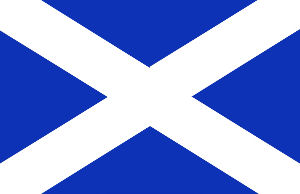

![]() Andrew was the brother of Simon Peter. The two of them were fishermen, and both were called by Jesus to be disciples. Prior to his calling by Jesus, Andrew was a disciple of John the Baptist. Following Jesus' crucifixion, His disciples were harrassed by the Roman authorities. Andrew traveled to the Scythia region of Asia Minor, preaching the gospel of Jesus and founding Christian communities. Andrew was taken at the city of Patras along the northern coast of the Peloponnese, and condemned to death by crucifixion himself. He requested that he not be crucified on a Latin cross as Jesus had been, but instead was bound onto an X-shaped cross, which thereafter became known as a "Saint Andrews Cross". After his death, Andrew was acknowledged as the patron saint of many countries.
Andrew was the brother of Simon Peter. The two of them were fishermen, and both were called by Jesus to be disciples. Prior to his calling by Jesus, Andrew was a disciple of John the Baptist. Following Jesus' crucifixion, His disciples were harrassed by the Roman authorities. Andrew traveled to the Scythia region of Asia Minor, preaching the gospel of Jesus and founding Christian communities. Andrew was taken at the city of Patras along the northern coast of the Peloponnese, and condemned to death by crucifixion himself. He requested that he not be crucified on a Latin cross as Jesus had been, but instead was bound onto an X-shaped cross, which thereafter became known as a "Saint Andrews Cross". After his death, Andrew was acknowledged as the patron saint of many countries.
![]() St. Andrew is considered the patron saint of Scotland, and therefore St. Andrew's Day has been called "Scotland's National Day". St. Andrew's Day was celebrated by Scots in the homeland and in the American Colonies.
St. Andrew is considered the patron saint of Scotland, and therefore St. Andrew's Day has been called "Scotland's National Day". St. Andrew's Day was celebrated by Scots in the homeland and in the American Colonies.
![]() The day, in Scotland, is known by the names: Andrys Day, Androiss Mess and Andermas.
The day, in Scotland, is known by the names: Andrys Day, Androiss Mess and Andermas.
![]() Processions would be held on St. Andrew's Day to honor the saint and plead for his blessing over the coming year. It was said that singed sheep's heads were carried in the procession. Hogg's Instructor, published by James Hogg at Edinburgh in 1851, noted that that sheep-heads "were carried before them, in allusion to the national dish of sheep-head broth."
Processions would be held on St. Andrew's Day to honor the saint and plead for his blessing over the coming year. It was said that singed sheep's heads were carried in the procession. Hogg's Instructor, published by James Hogg at Edinburgh in 1851, noted that that sheep-heads "were carried before them, in allusion to the national dish of sheep-head broth."
![]() It was a custom in Scotland for a young girl, who was anxious to know what color her future husband's hair would be, to take hold of the bedroom door latch at midnight on St. Andrew's Day eve, and call out three times: "Gentle love, if thou lovest me, show thyself!" Then, very quickly, she should open the door a few inches, and with her free hand, grab out in the dark. When she opens up that hand, she will find a lock of her future husband's hair.
It was a custom in Scotland for a young girl, who was anxious to know what color her future husband's hair would be, to take hold of the bedroom door latch at midnight on St. Andrew's Day eve, and call out three times: "Gentle love, if thou lovest me, show thyself!" Then, very quickly, she should open the door a few inches, and with her free hand, grab out in the dark. When she opens up that hand, she will find a lock of her future husband's hair.
![]() Nudity was required for another spell to be effective. Martin Luther noted in his Colloquia Mensalia, published in 1652, that during the evening before St. Andrew's Day, young maidens would strip themselves naked, and then recite a prayer to St. Andrew in order to learn what their future husbands might be like.
Nudity was required for another spell to be effective. Martin Luther noted in his Colloquia Mensalia, published in 1652, that during the evening before St. Andrew's Day, young maidens would strip themselves naked, and then recite a prayer to St. Andrew in order to learn what their future husbands might be like.
![]() St. Andrew's Flag, Scotland's national flag, known as the Saltire, consists of a diagonal white cross against a sky blue background.
St. Andrew's Flag, Scotland's national flag, known as the Saltire, consists of a diagonal white cross against a sky blue background.


